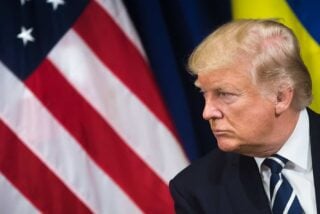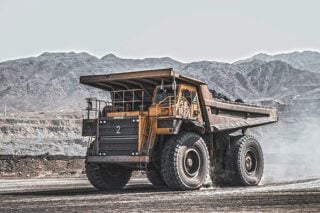
Politics can be ugly, and as we near Election Day – just a little more than a month away – that ugliness is sure to exhibit itself more and more. That’s true in any election year, but it seems even more true this year.
One of the biggest reasons that this election year seems so hostile is that one of the main party nominees has consistently shown himself to be abusive, obtuse and ignorant. Over and over again, Donald Trump has displayed a penchant to not only misunderstand the issues, but to back his own arguments with demonstrably false information and convoluted, often irrational, logic.
If Trump had kept his talking points to the many of the usual things that presidential nominees talk about – foreign relations, the economy, job growth, etc. – this blog post probably wouldn’t be written. Those things are important, but Mesothelioma.com is focused on spreading awareness about mesothelioma and asbestos exposure, which are topics that presidential candidates rarely bring up.
However, Trump has brought up asbestos. And like many of the statements he has made on other topics, he has proven himself to be ignorant about the actual dangers of asbestos exposure. Furthermore, his support of the asbestos industry and expanded use of the toxic substance – rather than an asbestos ban – shows that if Trump were to become president, his asbestos-related policies would likely lead to even more unnecessary deaths.
So what has Trump said in the past about asbestos? Here are a few of the things.
Trump Believes Asbestos Is a “Mob Conspiracy”
Forget more than a hundred years of medical and scientific research showing a clear link between asbestos and cancer (not to mention a host of other diseases). Forget the U.S. Environmental Protection Agency’s (EPA) statements that there is no safe level of asbestos exposure. Forget the thousands of individuals whose lives are ruined each year when they learn that they have been diagnosed with mesothelioma.
Trump knows better. Or so he claims.
In 1997, Trump published a book titled The Art of the Comeback. Embedded in that egoistic work of self-aggrandizement, Trump wrote the following:
- I believe that the movement against asbestos was led by the mob, because it was often mob-related companies that would do the asbestos removal. Great pressure was put on politicians, and as usual, the politicians relented. Millions of truckloads of this incredible fire-proofing material were taken to special “dump sites” and asbestos was replaced by materials that were supposedly safe but couldn’t hold a candle to asbestos in limiting the ravages of fire.
In addition, Trump goes on to say that asbestos is “100% safe” after it has been installed. While it is true that asbestos is somewhat less dangerous so long as it is not broken, any level of asbestos can lead to medical problems down the road. The Occupational Safety and Health Administration (OSHA) has shown that asbestos used in fireproofing is easily released into the air if disturbed – such as it will be during an actual fire.
Long story short, the medical and scientific evidence supporting the dangers of asbestos is clear. There is no conspiracy, no desire to make real estate developers like Trump pay more simply out of spite. Asbestos kills, and claiming that such deaths are false and part of a mafia conspiracy ignores all of the pain and suffering that real people feel every day due to this dangerous substance.
Trump Says the Twin Towers Fell Because They Didn’t Have Asbestos
The tragedy of September 11th will haunt us as a society long into the future. Even fifteen years later, we’re still learning about the lasting health effects of the attacks, especially the attacks on the World Trade Center towers in Manhattan.
The mechanical reasons for the fall of the Twin Towers is well established: When two hijacked airplanes flew into the towers, the buildings became structurally weakened and eventually collapsed. Subsequently, fires ignited at impact and exacerbated by the jet fuel spread during the collision caused the steel structural supports in the buildings to weaken, eventually resulting in the collapse of both buildings.
These explanations have been provided by multiple individuals and agencies, including the Structural Engineering Institute of the American Society of Civil Engineers (SEI/ASCE), the Federal Emergency Management Agency (FEMA), and the National Institute of Standards and Technology (NIST). While some of the specific details may differ in each report, all agree that both structural damage from the plane crashes and the intensity of the fires contributed to the World Trade Center Towers’ collapse.
Trump has a different idea. He believes that a lack of asbestos caused the buildings to fall.
This bizarre opinion was first voiced publicly in 2005, when Trump testified before the Senate Homeland Security and Governmental Affairs Committee, saying:
- In New York City, we have a lot of asbestos buildings. And there’s a whole debate about asbestos. I mean, a lot of people would say that if the World Trade Center had asbestos, it wouldn’t have burned down. It wouldn’t have melted, okay? A lot of people think asbestos— a lot of people in my industry think asbestos is the greatest fireproofing material ever made. And I can tell you that I’ve seen tested asbestos versus the new material that’s being used, and it’s not even a contest. It’s like a heavyweight champion against a lightweight from high school. But in your great wisdom, you folks have said that asbestos is a dangerous material and it has to be removed.
In 2012, Trump doubled down on his testimony in a tweet, writing, “If we didn’t remove incredibly powerful fire retardant asbestos & replace it with junk that doesn’t work, the World Trade Center would never have burned down.”
There are three primary problems with Trump’s amateur assessment of the structural collapse of the Twin Towers.
First of all, the towers did not burn down: They collapsed. While the collapse was not immediately caused by the impact of the commercial airliners slamming into the buildings, those impacts certainly contributed significantly to the event, weakening overall structural support. Analysis by both government and independent scientists showed that the multi-floor damage caused by the planes’ impacts on the buildings created a shift in how the building structure handled its own weight.
Secondly, the claim that there was no asbestos in the Twin Towers is inaccurate. The skyscrapers were built between 1968 and 1972, during which time about 400 tons of asbestos was used in the building. Some abatement and removal was done later, but there is evidence that a significant amount of asbestos was still contained in the buildings. In particular, a study by the EPA showed that asbestos made up approximately 4% of the dust created during the collapse of the Twin Towers.
Finally, even though fire did contribute to the weakening of the structural support in the World Trade Center, there is no guarantee that more asbestos would have done a better job of preventing the weakening. Reports by NIST, FEMA, and others indicate that the plane impacts caused fireproofing material to become dislodged, allowing fires to spread where they might not normally have gone. It is likely that the impacts of the planes would have allowed fire to spread around the fireproofing regardless of whether it was made of asbestos or another material.
Trump Wants to Limit Compensation for Asbestos Victims
As a known carcinogen, asbestos is a dangerous substance that should only be used in extremely limited circumstances, if at all. However, even after discovering the link between asbestos and mesothelioma, many companies continued to use the deadly toxin, thereby poisoning their own workers, customers, and others who come into contact with their products.
As a result, some companies have been forced to admit liability for their negligence in continuing to use asbestos. In certain cases, companies have been forced by the courts to set up asbestos trust funds, out of which they are required to pay victims of mesothelioma and other asbestos-related diseases. Other asbestos companies have not set up trust funds, but have chosen to make settlements, or in some cases, forced to pay judgment amounts to mesothelioma patients or their families.
Trump believes that companies that have exposed their employees, customers, and others to asbestos should not be held liable in this way. As a supporter of a broad scheme of so-called “tort reform,” Trump wants to limit how much victims of asbestos abuse can receive for their medical bills, lost income, and other costs tied to their diagnosis.
Given these positions, it is clear that Trump does not understand how dangerous asbestos is. Nor does he realize the impact that asbestos has had on the real lives of real individuals. Or if he does realize these things, he simply doesn’t care.
One thing seems certain: If Trump makes it to the White House, it seems unlikely that an asbestos ban will pass anytime soon. Given the excitement about the passage of the Lautenberg Chemical Safety Act earlier this year, pausing our progress at this point would be devastating.




